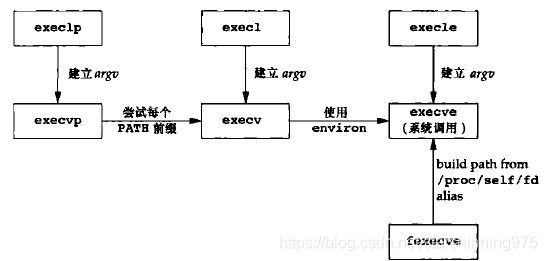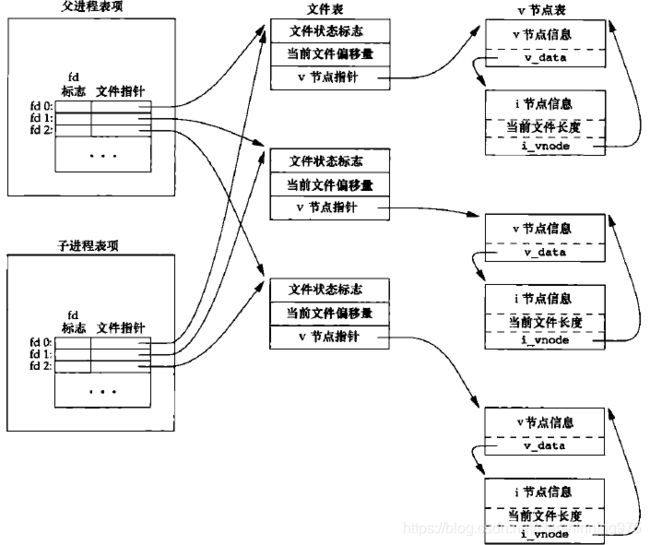第八章-进程控制
进程控制
- 进程标识
- 函数fork
- 函数vfork
- 函数exit
- 函数wait、waitpid和waitid
- 竞争条件
- 函数exec
- 更改用户id和更改组id
- 解释器文件
- 函数system
- 进程会计
- 进程调度
- 进程时间
进程标识
- 进程标识是非负整数,具有唯一性和可复用性
- ID为0的进程通常是调度进程(swapper),是内核的一部分,ID为1的进程通常是init进程,是一个普通的用户进程,通常读取与系统有关的初始化文件,该进程在自举过程结束时由内核调用,ID为2的进程是页守护进程,负责支持虚拟存储器系统的分页操作。
获得相关标识符的函数
#include 函数fork
#include - 写时复制技术,并不执行一个父进程数据段、栈和堆的完全副本
- 父进程和子进程共享正文段
- 父进程和子进程共享同一个文件偏移量
- 父进程和子进程谁先执行并不确定
- 父进程和子进程每个相同的打开描述符共享一个文件表项
函数vfork
#include 在子进程调用exec、exit或_exit之前,它在父进程的空间中运行
函数exit
#include - 调用各个终止处理程序(在调用atexit函数时登记)
- 关闭所有标准I/O流
- 调用_exit函数或_Exit函数
函数wait、waitpid和waitid
#include 下面是一个fork两次以避免僵死进程的实例
#include "apue.h"
#include 竞争条件
当多个进程都企图对共享数据进行某种处理,而最后的结果又取决于进程的顺序时,我们认为发生了竞争条件。
函数exec
#include fork函数创建新的进程,调用一种exec函数执行另一个程序,exec只是用磁盘上的一个新程序替换当前进程的正文段、数据段、堆段和栈段,并不改变进程ID。
7个exec函数的区别如下,

- 可执行文件引用的方式,取路径名,文件名或fd(PATH变量包含了一张目录表-称为路径前缀)。
- 参数表,列表方式要求每个命令行参数都说明为一个单独的参数,矢量方式要求用一个指向各参数的指针数组。
- 环境表,用environ变量为新程序复制现有的环境,e方式用一个指向环境字符串的 指针数组。
系统对环境表和参数表的总长度都有一个限制
grep getrlimit /usr/share/man/*/*
find /usr/share/man -type f -print | xargs grep getrlimit
find /usr/share/man -type f -print | xargs bzgrep getrlimit
对打开文件的处理:每个描述符执行时关闭标志,若设置了该标志,则在执行exec时关闭该描述符。
以下是这7个函数的关系,只有execve是系统调用

更改用户id和更改组id
解释器文件
其起始行的形式:
#! pathname[optional-argument]
以上感叹号和pathname之间的空格是可选的
当调用exec函数的过程时实际上内核执行该解释器文件第一行中pathname所指定的文件。
下面是一个调用exec函数执行一个解释器文件的实例
#include "apue.h"
#include 解释器文件的内容如下
#! /home/xiangke/bin/echoall foo
示例程序执行时,内核exec如上解释器文件定义的解释器“/home/xiangke/bin/echoall”,结果如下

前两个参数是解释器及其可选参数,后面的参数才是exec函数传入的参数
在解释器文件中用-f选项,如下是一个awk脚本文件
#!/usr/bin/awk -f
# Note: on Solaris, use nawk instead
BEGIN {
for (i = 0; i < ARGC; i++)
printf "ARGV[%d] = %s\n", i, ARGV[i]
exit
}
该awk脚本可像shell脚本一样执行,如下
xiangke@xiangke-virtual-machine:/home/apue.3e/proc$ sudo ./awkexample file1 FILENAME2 f3
ARGV[0] = awk
ARGV[1] = file1
ARGV[2] = FILENAME2
ARGV[3] = f3
函数system
#include 在unix系统中,system总是可用的,在其实现中调用了fork、exec和waitpid,有三种返回值
- fork失败或者waitpid返回出错(除EINTR之外),返回-1
- exec失败,如同shell执行了exit一样
- shell的终止状态
进程会计
#include - 进行进程会计处理,每当进程结束时内核就写一个会计记录。
- 会计记录写到指定的文件,linux系统中,该文件是/var/account/pacct或/var/log/account/pacct
- 相关命令是accton
- 会计记录结构定义在头文件
,如下:
struct acct
{
char ac_flag; /* Flags. */
u_int16_t ac_uid; /* Real user ID. */
u_int16_t ac_gid; /* Real group ID. */
u_int16_t ac_tty; /* Controlling terminal. */
u_int32_t ac_btime; /* Beginning time. */
comp_t ac_utime; /* User time. */
comp_t ac_stime; /* System time. */
comp_t ac_etime; /* Elapsed time. */
comp_t ac_mem; /* Average memory usage. */
comp_t ac_io; /* Chars transferred. */
comp_t ac_rw; /* Blocks read or written. */
comp_t ac_minflt; /* Minor pagefaults. */
comp_t ac_majflt; /* Major pagefaults. */
comp_t ac_swaps; /* Number of swaps. */
u_int32_t ac_exitcode; /* Process exitcode. */
char ac_comm[ACCT_COMM+1]; /* Command name. */
char ac_pad[10]; /* Padding bytes. */
};
进程调度
#include 进程时间
#include :
struct tms {
clock_t tms_utime; /* user time */
clock_t tms_stime; /* system time */
clock_t tms_cutime; /* user time of children */
clock_t tms_cstime; /* system time of children */
};*/
/*times() returns the number of clock ticks that have elapsed since an arbitrary point in the past*/
/*The number of clock ticks per second can be obtained using:
sysconf(_SC_CLK_TCK);*/
